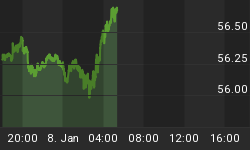
Last Monday GoldMoney published my article showing the frightening growth in money-quantities for the US dollar. In that article I stated that the hyperbolic rate of increase, if the established trend is maintained, is now running at over $300bn monthly, while the Federal Reserve is officially expanding money at only $85bn.
The first thing to note is that the Fed issues money because it deems it necessary. The hyperbolic trend increase in the quantity of money is a reflection of this necessity, implying that if the Fed's money issuance is at a slower rate than required, then strains will appear in the financial system. There are a number of reasons behind this monetary acceleration, not least the need to perpetuate bubbles in securities markets, but there are three major underlying problems.
Government spending
Federal government spending is accelerating, due to rapidly escalating welfare commitments, not all of which are reflected in the budget. Demographics, particularly the retirement of baby-boomers, government-sponsored healthcare, and unemployment benefits are increasing all the time; yet the tax base is contracting because of poor economic performance and tax avoidance. Furthermore, state and municipal finances are dire.
Economy
The US economy is overloaded with debt to the point that it no longer reacts positively to monetary stimulus, and successive government interventions have led misallocation of economic resources to accumulate towards crisis levels. The private sector is now teetering on the edge of an abyss overloaded by both debt and government intervention.
Commercial banks
The banks are cautious about lending to indebted borrowers, and they have failed to adequately devalue collateral against existing loans. The result is that with no bank credit being made available to support renewed buying of assets, asset valuations are constantly on the verge of collapse. Put another way, banks have backed off from creating ever-increasing levels of debt to perpetuate the pre-crisis asset bubble.
One should not take comfort in attempts to improve asset ratios. According to the Federal Deposit Insurance Corporation, the ratio of total assets to risk-adjusted Tier 1 level capital is currently 11.25; but this does not adequately reflect off-balance sheet activities and non-banking business such as derivatives. The inclusion of derivatives on US bank balance sheets as a net as opposed to gross exposure, seriously misstates actual risk.
Banks therefore face two different problems. An on-paper write-down of collateral assets of less than 9% wipes out the entire banking system, with a far lower threshold for many banks. Changes in GAAP accounting rules over asset valuations in the wake of the Lehman crisis have allowed them to hide losses, a situation that is still unresolved and suggests the banking system is already close to the edge. Furthermore, any failure in the derivative counterparty-chain threatens to trigger a collapse of the larger banks where derivative exposure is concentrated.
Conclusion
We are in the eye of a financial storm, for which the only solution - other than mass default - is an accelerating supply of money. Deteriorating financial conditions in either government, banks, private sector or securities markets are almost certain to trigger a run on the others. And that is why a far larger figure than QE3's $85bn per month may be required to keep the system afloat.
















